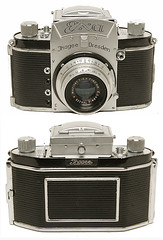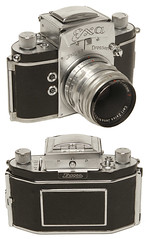Difference between revisions of "Exa (original)"
m (A few more edits and links) |
(Added images of more types) |
||
| Line 1: | Line 1: | ||
| − | {{ | + | <div class=floatright> |
| − | | image_source=http://www.flickr.com/photos/16822508@N05/2354348795/in/pool- | + | {{Flickr_image |
| − | | image=http://farm3.static.flickr.com/2252/2354348795_5ce0198078.jpg | + | |image_source= http://www.flickr.com/photos/16822508@N05/2354348795/in/pool-camerawiki/ |
| − | | image_align= | + | |image= http://farm3.static.flickr.com/2252/2354348795_5ce0198078.jpg |
| − | | image_text= | + | |image_align= |
| − | }} | + | |image_text= Exa type 4 with a prism finder and a Trioplan (mounted on a teleconverter) |
| + | |image_by= John Nuttall | ||
| + | |image_rights= with permission | ||
| + | }} | ||
| + | </div> | ||
| + | The original '''Exa''' is a [[35mm]] [[SLR]] launched in 1951. It is part of the [[Exa|Exa series]] made in Germany by [[Ihagee]]. It is a simplified version of the Varex cameras (the Exacta V and VX); indeed, the first models, made in very small numbers in 1950, were labelled Exa Varex<ref>[[McKeown]], p 422.</ref>. It includes the bare necessities of internal mechanisms. In place of a focal plane shutter, the mirror doubles as the 'opening' shutter blade, and a curved metal guillotine is the 'closing' blade<ref>The medium-format KW [[Pilot Super]] has a very similar shutter mechanism.</ref>. This shutter is not capable of either very fast or slow speeds; the range is from 1/25 sec. to 1/150 sec<ref>The very earliest model claimed a top speed of 1/250 second ([[McKeown]]).</ref>. The low maximum shutter speed limits the usefulness of the camera with long lenses. The camera is quite compact and very robust, and can use the same finders, lenses and the wide range of other accessories as the more expensive Exacta cameras. | ||
| − | + | Between 1951 and 1962, a number of cosmetic and minor technical changes were made in the design of the camera. A numbering system devised by Clément Aguila<ref>Aguila, Clément ''Exacta Cameras 1933-1978'', ISBN 0-906447-38-0. Cited by [[McKeown]].</ref> is widely used<ref>By McKeown, in Olaf Nattenberg's [http://www.exaktapages.com/ Exacta and Exa Pages] and in Jack Dugrew's [http://captjack.exaktaphile.com/index.htm Captain Jack's Exacta Site] among others</ref>. This recognises six major types, distinguishable by changes in the finish of the lens mount, the number, finish and synchronisation class of the [[flash sync]]hronisation sockets, and the style of the nameplate, among other features. | |
| − | |||
| − | Between 1951 and 1962, a number of cosmetic and minor technical changes were made in the design of the camera. A numbering system devised by Clément Aguila<ref>Aguila, Clément ''Exacta Cameras 1933-1978'', ISBN 0-906447-38-0. Cited by [[McKeown]].</ref> is widely used<ref>By McKeown, in Olaf Nattenberg's [http://www.exaktapages.com/ Exacta and Exa Pages] and in Jack Dugrew's [http://captjack.exaktaphile.com/index.htm Captain Jack's Exacta Site] among others</ref>. This recognises six major types, distinguishable by changes in the finish of the lens mount, the number and | ||
==Notes== | ==Notes== | ||
<references /> | <references /> | ||
| + | |||
| + | {{Br}} | ||
| + | |||
| + | {|class=plainlinks align="center" | ||
| + | || | ||
| + | {{Flickr_image | ||
| + | |image_source=http://www.flickr.com/photos/ricksoloway/1807769497/in/pool-camerawiki/ | ||
| + | |image=http://farm3.static.flickr.com/2256/1807769497_c7ef4c63b8_m.jpg | ||
| + | |image_align= | ||
| + | |image_text=Exa type 1.1, with a Meritar, a common entry-level lens | ||
| + | |image_by= Rick Soloway | ||
| + | |image_rights= with permission | ||
| + | }} | ||
| + | || | ||
| + | {{Flickr_image | ||
| + | | image_source=http://www.flickr.com/photos/ricksoloway/3884359380/in/pool-camerawiki/ | ||
| + | | image=http://farm4.static.flickr.com/3456/3884359380_05b03b6249_m.jpg | ||
| + | | image_align= | ||
| + | | image_text=Exa type 4, with a Tessar. | ||
| + | | image_by=Rick Soloway | ||
| + | | image_rights=with permission | ||
| + | }} | ||
| + | || | ||
| + | {{Flickr_image | ||
| + | |image_source=http://www.flickr.com/photos/s-demir/5311905014/in/pool-camerawiki/ | ||
| + | |image=http://farm6.static.flickr.com/5048/5311905014_731a00b853_m.jpg | ||
| + | |image_align= | ||
| + | |image_text= Exa type 6, with 'zebra' Pancolar. The original VF for the type 6 was finished in leatherette. | ||
| + | |image_by= Süleyman Demir | ||
| + | |image_rights= with permission | ||
| + | }} | ||
| + | |- | ||
| + | |} | ||
| + | |||
==Links== | ==Links== | ||
Revision as of 01:33, 27 March 2011

|
| Exa type 4 with a prism finder and a Trioplan (mounted on a teleconverter) image by John Nuttall (Image rights) |
The original Exa is a 35mm SLR launched in 1951. It is part of the Exa series made in Germany by Ihagee. It is a simplified version of the Varex cameras (the Exacta V and VX); indeed, the first models, made in very small numbers in 1950, were labelled Exa Varex[1]. It includes the bare necessities of internal mechanisms. In place of a focal plane shutter, the mirror doubles as the 'opening' shutter blade, and a curved metal guillotine is the 'closing' blade[2]. This shutter is not capable of either very fast or slow speeds; the range is from 1/25 sec. to 1/150 sec[3]. The low maximum shutter speed limits the usefulness of the camera with long lenses. The camera is quite compact and very robust, and can use the same finders, lenses and the wide range of other accessories as the more expensive Exacta cameras.
Between 1951 and 1962, a number of cosmetic and minor technical changes were made in the design of the camera. A numbering system devised by Clément Aguila[4] is widely used[5]. This recognises six major types, distinguishable by changes in the finish of the lens mount, the number, finish and synchronisation class of the flash synchronisation sockets, and the style of the nameplate, among other features.
Notes
- ↑ McKeown, p 422.
- ↑ The medium-format KW Pilot Super has a very similar shutter mechanism.
- ↑ The very earliest model claimed a top speed of 1/250 second (McKeown).
- ↑ Aguila, Clément Exacta Cameras 1933-1978, ISBN 0-906447-38-0. Cited by McKeown.
- ↑ By McKeown, in Olaf Nattenberg's Exacta and Exa Pages and in Jack Dugrew's Captain Jack's Exacta Site among others
|
|
|
Links
- Several of the Exa types are shown in the Exa Gallery on Olaf Nattenberg's Exakta and Exa Pages (text in German)


